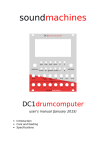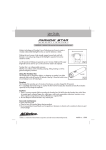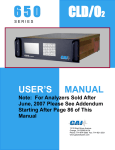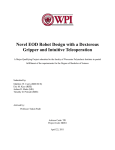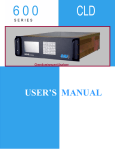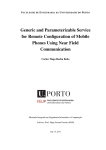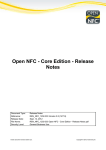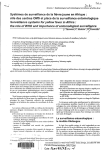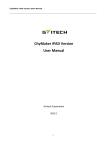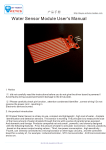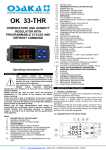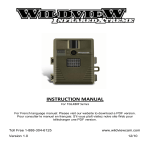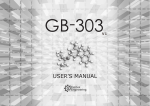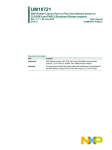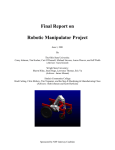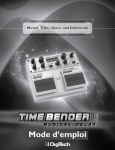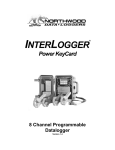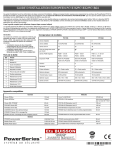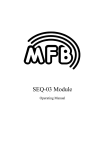Download DC1drumcomputer
Transcript
DC1drumcomputer user's manual (draft) Module Panel • • • • • pattern display: an 8x16 led matrix display that shows the pattern configuration and the other user interface functions. row/menu encoder: this encoders selects the row (track) on the pattern display and, if pressed, enters the MENU section col/select encoder: this encoder selects the column (step) on the pattern display and the values of the various parameters in all the user functions. When pressed, typically selects or confirm the current action. In 'pattern edit' mode, the step gets activated or de-‐activated by pressing this button. play button: this button starts the sequencer and, if pressed again, pauses the sequence. When the sequencer enters the pause state a pause symbol is shown briefly. When pressed again the sequence starts from the next active step. stop button: this button stops the sequence and resets the step to the first (1) for all the tracks. • • • • • • • • • • • • load button: when pressed, the display will show, as lit dots, the potential location for loading a pattern from memory (either 16 or 128, depending on the firmware release and the presence of the SDcard). The user will select, with the col/sel encoder, the location and, by pressing the col/sel encoder, loads it into memory. o A sequence is defined as a set of tracks, the sequence speed, the individual tracks lenght, the gate lenght, the shuffle and the 4 CV bound functions. store button: As above, the user is prompted with a graphical display of the possible locations where to save the present pattern. When selected with the right encoder, by pressing it the sequence is saved and the modue confirms with an "OK". tempo button: when pressed, the right encoder selects an integer BPM value between 1 and 240 BPM. To confirm, press the encoder or wait 5 seconds to return to the original tempo. len button: when pressed, the display shows as ALL LIT the #1 track. The user selects the track with the LEFT encoder and the LEN of the track with the RIGHT encoder. The length of the LIT track changes according to this parameter. To confirm, the user have to press the right encoder. NO track could be longer than "glob len" value. (IMPORTANT, the active steps are retained in memory even if out of scope) glob len button: when pressed the user selects the LEN of the sequence. If there are already different track lengths the global len affects only the tracks that have a len>globlen (IMPORTANT, the active steps are retained in memory even if out of scope) shuffle: when the user press this button, a 'shuffle', (or swing) percentage is shown on the display (from 50 to 100). To confirm, press right encoder. Note: When external clock is choosen, shuffle is not enabled. A,B,C,D buttons: when pressed, the user can choose for the CVinput A,B,C or D, a parameter that is shown by rotating the right encoder and confirmed with the push of the encoder (see the CV parameter chapter) clk in jack: this input accepts 5V clock signals when the switch is positioned on the left. The clock could be divided usign the relevant menu function. clock switch: selects whenever the clock is internal or external. clkout/res: when in external mode this is an input and, if HIGH resets the sequence to step 1. When in internal mode the clock of the sequence is output from this jack to sync with other equipment. Level is 5V. The clock out shape takes gate length and shuffle in consideration. start/stop: this input, along with the button, starts and stops the sequence. The two methods of control are concurrent, i.e. when the input on the jack is ZERO and the user presses the start button the sequence starts, etc... CVA-‐CVD: CV inputs for configurable functions. Those are 0-‐5V inputs. Modes of operation EDIT MODE: As soon as the user touches one of the encoders, the display will show a blinking dot on the matrix. The user can now move the dot by means of the two encoders (row/column). The blinking of the dot is different depending if it sits on an active step or not. When the user presses the right encoder the status of the 'pointed' step changes, cycling through ACTIVE and NON ACTIVE states. After 5 seconds of inactivity the module returns to either the STOP mode or the RUN MODE. STOP MODE: the matrix shows the active sequence, the sequencer is stopped and the module is waiting for input form the user OR from the external signals. RUN MODE: When the sequencer is active and running, and the user is not operating the unit on other modes, the display shows the 'active sequence' and, for each track, a DOT shows the current steps, moving with the clock. The status of the steps are X-‐OR'ed (inverted) as the sequence progresses. If the length of the tracks are all equal the user sees a vertical bar that is running on the matrix. MENU MODE: By pressing the LEFT encoder the user enters the MENU mode, and the screen shows menu items as defined below. When the user selects a menu item with the left encoder push, enters the PARAMETER CHANGE phase and can change (with the right encoder) the value of the parameter. Confirmation (end EXIT from MENU MODE) is made through a push on the right encoder. MENU MODE is also exited by pushing the LEFT encoder or by waiting 20 seconds. Menu Items: GATE LENGHT (GATL) (1..12) • This is the lenght of the gate/trigger signal. It is expressed in 24th of a step 12 is the default and the maximum value. ROLLS TYPE (ROLL) (2,3,4) • The type of the 'rolls', or multiple hits during a single step. 2 is the default. With 2, max gatelength is 11, with 3 max gatelength is 7, with 4 max gatelength is 5. CLK DIV PER TRACK (CKD1-‐CKD8)(1,2,4,8,16,24,32,64) • You can alter the clock division for each track. 1 is the default on all the tracks. PRESETS (PREa-‐PREh): • You can choose one of out 16 preset rhythms. An hommage to the old fixed pattern drum machines (the pattern takes up no memory) SONG MODE (SNGM) • • • • • • • OFF (default, exit from SONG MODE) SNG2 (the active pattern and the following one are cycled) SNG4 (the active pattern and the following three are cycled) SNG8 (the active pattern and the following eight are cycled) SNGa (the active pattern is the first of four: AAAB) SNGb (the active pattern is the first of four: ABAC) etc... CVx modes: LOOP1 (LOP1): each rising edge on the CVx input selects the next sequence and loops at the end of the available memory (so 16 or 128 seq). The new pattern is started at the end of the current one. LOOP4(LOP4): each rising edge on the CVx input selects the next sequence starting from the active one until the fourth. After it the next sequence will be the first again. The sequence is started at the end of the current one. LOOP8(LOP8): see above, longer. RANDOM SEQ (RNDS): each rising edge on the CVx input selects a random sequence among the saved ones. The sequence is started ad the end of the current one. TEMPO: (TMPO)The CVx analog value is mapped linearly into BPMs SHUFFLE: (SHFL)The CVx analog value is mapped into shuffle LEN8 (HALF): a high value on the CVx input sets the pattern lenght to eight steps LEN4 (FRTH): a high value on the CVx input sets the pattern length to four steps (((((TRACK CLOCK 1-‐8 (CLK1-‐CLK8): the CVx input is used as one of the track's clock.))))) FILL-‐IN A-‐H (FILa-‐FILh): the rising edge on the input triggers the start of a 'fill' pattern and at the end the sequencer returns to the original sequence. The fill-‐in patterns are ALWAYS the last eigth of the memory (8-‐16 in case of the first release and 112-‐128 in case of the second release of firmware and the presence of the SDcard) DENSITY (DNS1-‐DNS8): the input voltage is mapped into the random density 'around' the active steps in the pattern. RANDOM BEATS (RND1-‐RND8): the input voltage randomizes the active steps. EUCHLYD BEATS (EUC1-‐EUC8): the input voltage generates "really cool" euchlydean rhythms. Mapping, measures, etc... will be defined. TRACK GATE LENGTH (TGL1-‐TGL8): the input voltage changes the gate length of the track. TRACK MUTE 1-‐8 (MUT1-‐MUT8): a high level on the input "mutes" the output of the corresponding track. ROLLS 1-‐8 (ROL1-‐ROL8): a roll is made in the choosen track at the current step (the roll type is defined in the MENU section). Rolls are NOT ACTIVE when external clock is selected. LEGENDA: "active sequence" the set of track/parameters that is loaded in memory and ready to be played or playing.





